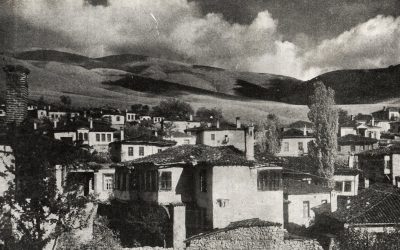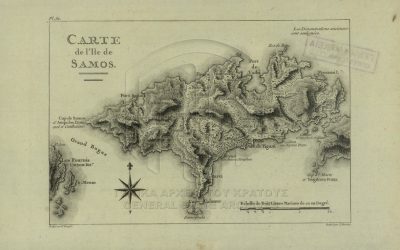By George Zimmar
When we think of a pilgrimage, like Chaucer’s Canterbury Tales, a spiritual journey comes to mind. My grandfather Georgios Zymaras (or Zoumaras), made a pilgrimage to Jerusalem in 1900, where he prayed before the tomb of Christ, and earned Hadji attached to his surname. Hadji probably taken from the practice of Moslems of making a pilgrimage to Mecca, a Hadj. My pilgrimage to Laconia was to pay tribute to the places where my parents, Panagiotis (Peter) and Sofia, were born and grew up; a pilgrimage to one’s origins.
I made a trip for the first time to my mother’s village with my sister Peggy and our first cousin, Falia. We drove in my 1966 Volvo from Athens to the plains of Sparti. This was years before the National Highway that tunneled through the mountains was built, so the trip took six hours through bruising hairpin turns though Northern Peloponnesus that tossed my passengers from side to side in the car arriving, as we did, late afternoon in Sparti somewhat shaken.
My mother’s lineage is traced to the killing of a Turk in the village of Bertzovas (now Partheni), near Tripoli in late Ottoman times. Four Kanellis brothers split for different parts of Laconia to avoid capture: two to Geraki, one to Gouves, and another to Zaganou. Years before, on her deathbed, the childless wife of the Kanellis ancestral forebearer instructed her husband to marry the young gypsy servant tending her at bedside. The apocryphal family narrative is that the Kanellis line, which included the four brothers, issued from this union.
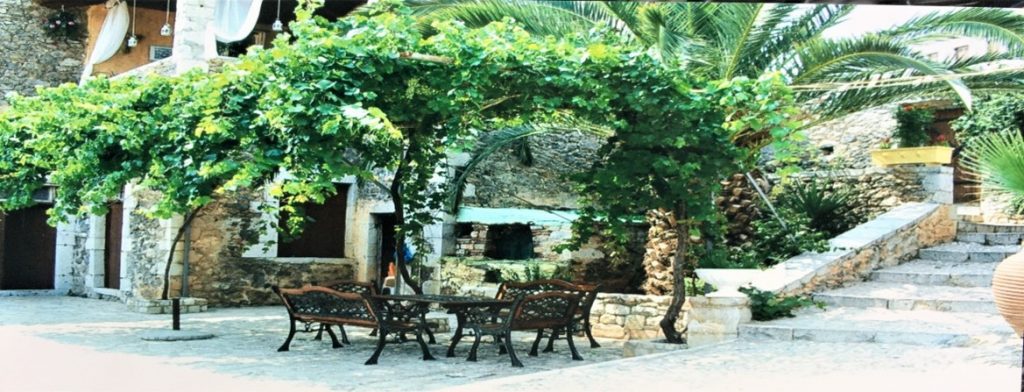
Years later, a descendant, Athanasios P. Kanellis (1836–1905) married Aikaterini A. Maroudas (1844–1910) in Geraki, and their son, Diamantis A. Kanellis (1870–1951) was to be my maternal grandfather. He married Garyfalia Doulfas (d.1966), the daughter of priest, Michail Doulfopoulos, in 1902. They had eight children: my precious aunts, uncles, and mother, Sofia. Diamantis was a substantial landowner, respected mayor, and godfather to many children in Geraki and surrounding villages. After the villagers of Geraki had turned over the annual olive crop to a flimflam exporter who ran off with the receipts of the sale, Diamantis reimbursed every family for their loss. Such civic duty typifies the Kanellis family.


In Greece, my sister and I visited with my mother’s brothers and sisters, our beautiful and loving aunts and uncles, and got to know our Kanellis cousins. From Sparti, we travelled 40km to Geraki, to the spacious home built in 1900 by Diamantis Kanellis. Uncle Michalis, mom’s brother, was caring for my dad’s properties. We decided to go to Kosmas to see where my father’s ancestors -Anagnostis, Athanasios, Georgios, and my dad, Panagiotis- had set their roots. None of the Zymaras clan were living in Kosmas or Vrontamas, and their homes were vacant. However, my paternal grandmother’s relatives, the Karkas family, were still living in Kosmas. We piled into the Volvo, Uncle Michalis, his daughters, Falia, and Manta, cousin Falia, son Diamantis, and my sister Peggy. Uncle Michalis questioned why in the world would I buy a two-door passenger car, when four-doors were available. Was it a matter of cost? This was a question raised by all my Greek relatives. Why only two-doors? I believe this query speaks to the contrast between how Americans and Greeks relate to their cars. In the US, style and size matters, whereas in Greece and Europe, economy and convenience of passengers is sought. For Americans appearance takes precedence over the comfort of fellow travelers. A sleek sporty two-door is preferred over a cumbrous and clunky four-door sedan that offers the wellbeing and felicity of the passengers.
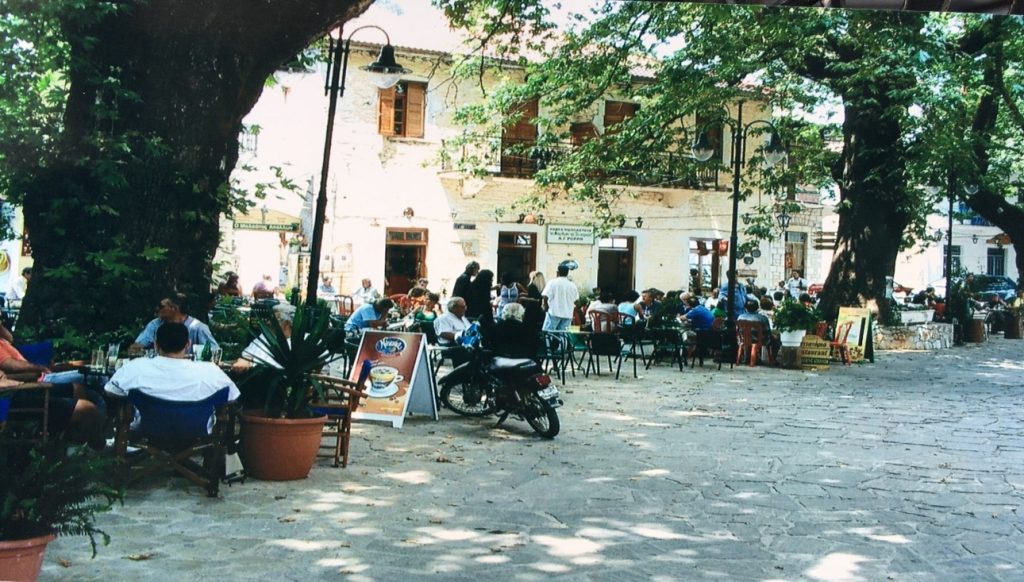
The four girls cramped in the back seat of the Volvo with Uncle Michalis and Diamantis in his lap and I in front, and off we went up and around the craggy rock-strewn road to the beautiful village, Kosmas.
Kosmas is a small town in the mountains of Arcadia on Mount Parnon, an hour or so from Tripoli, Sparta, Leonidion and the east coast of the Peloponnesus. Surrounded by forests of chestnut trees and pine, it is high enough for there to be a difference in temperature of ten or more degrees from these other places. In the summer it is cool and, in the winter so cold that residents go south to their homes in Vrontamas. The village is set near the top of Mount Parnon and from my father’s house a glimpse of the Myrtoan Sea and the Isle of Spetses can be seen. However, the nearby plateia is one the most beautiful village squares in Greece with a wide spreading oak tree shading the entire square. The Lion Fountain of Kosmas splashes coldest mountain water throughout the summer months. We escaped the hot summer sun of Laconia at my father’s house.
Do you like this “Yiayia & Me” story? Help us with the next one!
Share your story or consider a donation and make your yiayia proud!
Located on the road from Leonidion and near the plateia, the house had two floors with the ground level for storage, and the animals in the winter to provide their body heat for the occupants above in winter. Upstairs a fireplace (tzaki) and rooms for sleeping and wood working. We explored the property and Diamantis found a hteni (which he is holding in the photo) which for many years was the main product of the Kosmites.
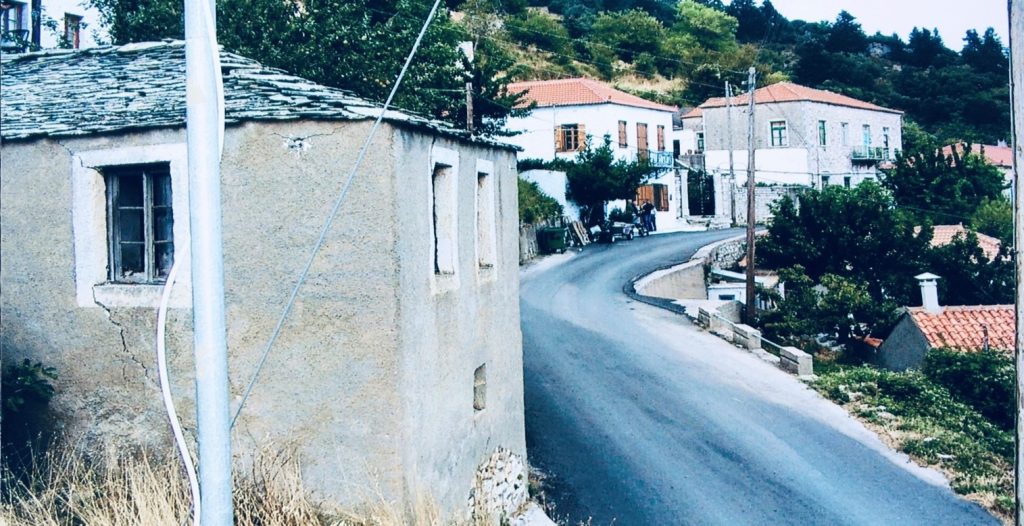
A hteni is the reed fit into a loom through which the fibers pass to make cloth. Made of pine strips and smoothed so that the fibers pass through the needle undamaged. Kosmites spent the winter months striping pine to fashion htenia. In the spring, they travelled to towns in Greece and the Ottoman regions and repaired standing looms with the parts that they had accumulated over the winter for making htenia. Grandfather Georgios and dad as a young lad supplemented their income with such toil far from Kosmas. As strangers (xenoi) in different locales, the Kosmites had developed a dialect for communication among themselves. For instance, coffee was moudzo and young woman, poula. Much of the dialect and the skill for making htenia passed from memory when my father left Kosmas for the United States, but his capacity for hard work remained.
I felt close to the picturesque Kosmas and to my father’s roots in Arcadia. However, my mother’s village Geraki, was home, with loving family: uncles, aunts, and cousins. My physiognomy resembled more the maternal side than the paternal, and they treated me as one of theirs. We clambered back into the car leaving the cool Kosmas for the warmth of Geraki.


